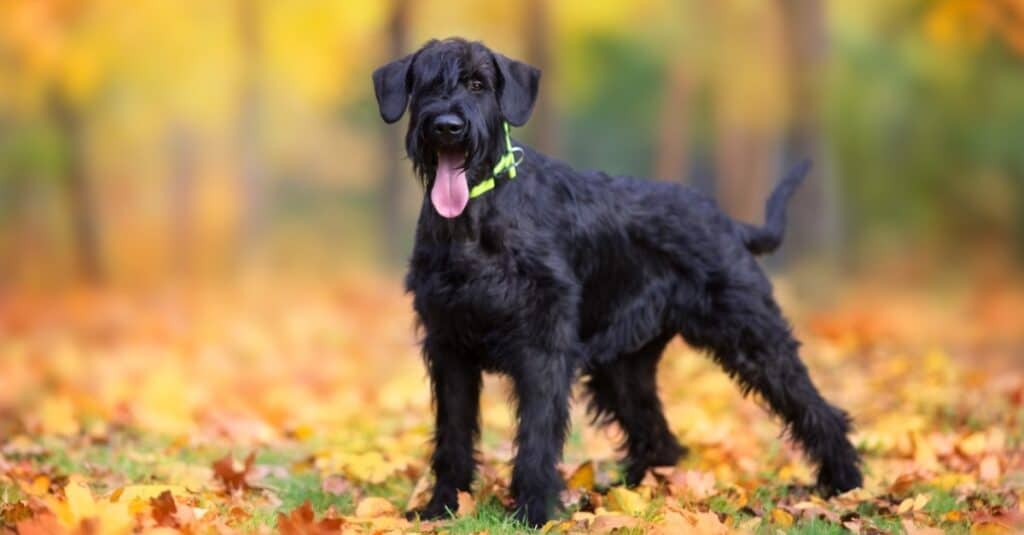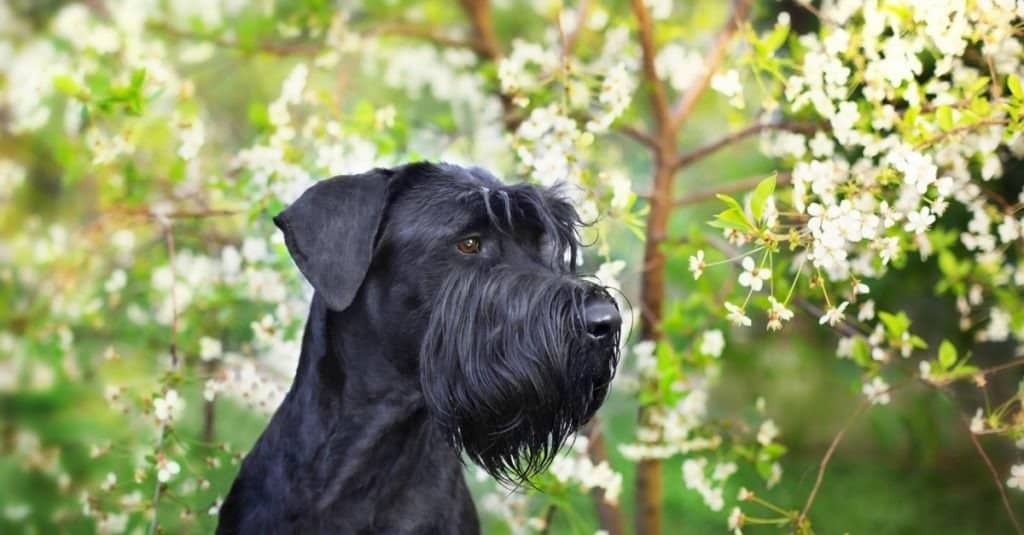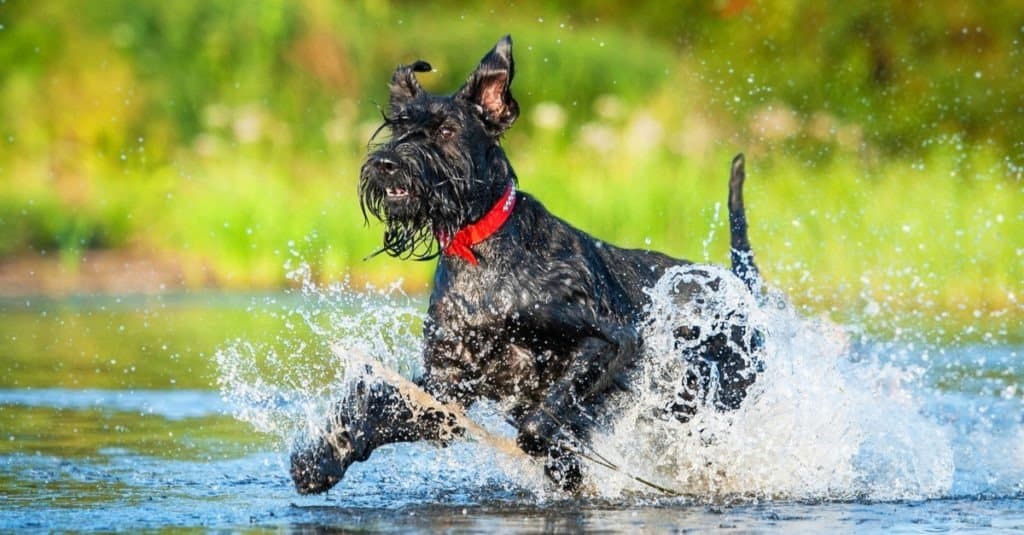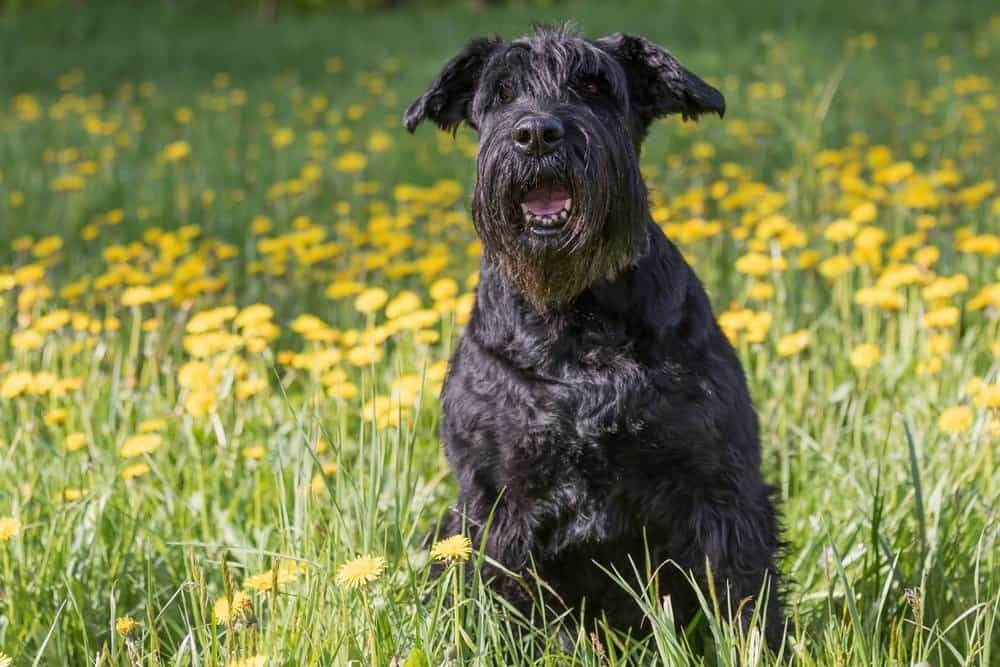Giant Schnauzer (original) (raw)
Developed in Bavaria, Germany, during the 19th century, standard Schnauzers and Great Danes were crossbred to produce a larger, more robust working animal. The resulting Giant Schnauzer—marked by its loyalty, alertness, and intelligence—was recognized in 1930 by the American Kennel Club.

The origin of the Giant Schnauzer is traced to 19th-century Bavaria, Germany.
©iStock.com/Nemyrivskyi Viacheslav
Giant Schnauzers initially were used to drive cattle from the farms where they grazed to the markets where they were sold. They were also tapped by innkeepers, farmers, and merchants as guard dogs. Soon, though, railroads made their principal work obsolete, so Giant Schnauzers found themselves working with the police and the military throughout Europe.
Today, many active families welcome this dog into their homes for its characteristically loyal and alert temperament. Giant Schnauzers are generally known for their devotion to their human companions.
Appearance, Size, and Weight
These dogs are easily recognizable as a bigger version of the Miniature and Standard Schnauzers as they feature the same eyebrows and beard that are distinct to its smaller versions. Although the name includes the word “giant,” this breed is not included in the group of giant breeds, which include, among other breeds, the Great Dane and Newfoundland.

The Giant Schnauzer appears quite distinguished with the eyebrows and beard so closely associated with all Schnauzer breeds.
©Kwadrat/Shutterstock.com
Giant Schnauzer’s dense, wiry medium double coat, which is also water resistant, is found in two colors: either black or salt and pepper. While this breed has somewhat high grooming needs to maintain its coat, ear health, nails, and teeth, the good news is that this breed does not shed much and is hypoallergenic.
They are quite big, though. Males typically weigh between 60 and 85 pounds and are between 25.5 and 27.5 inches tall. As is common, females typically weigh less and are not as tall. They are usually between 55 and 75 pounds and are between 23.5 and 25.5 inches tall. At 3 months old, Giant Schnauzer puppies generally weigh between 21 and 37 pounds already; at 6 months, between 39 and 68 pounds, but this breed finishes growing between the ages of 16 and 19 months.
Temperament and Behavior
The Giant Schnauzer’s temperament is marked by restraint, loyalty, alertness, high intelligence, and suspicion. They are noted for trusting and being loyal to their family but are weary of new people and places. With their background as guard dogs, owners should anticipate this breed could exhibit aggressive behavior if they feel threatened. Early training and regular exercise will help to restrain the worst behaviors.
As a working breed, the Giant Schnauzer requires plenty of mental stimulation; if not, the dog can easily bore and become destructive. Accompanying their owners on walks, hikes, bike rides, trips to the dog park for fetch, and other high energy activities are encouraged.

Giant Schnauzers require lots of mental stimulation and physical activity.
©Rita_Kochmarjova/Shutterstock.com
While this breed does make a good companion for active families, it is recommended that children be 12 or older before welcoming this dog into your home. Schnauzers, regardless of size, have big, bold personalities.
Common Health Issues
An overall healthy breed, Giant Schnauzers do develop conditions such as hip dysplasia, eye disease, and autoimmune thyroiditis, but this can largely be avoided by procuring your Giant Schnauzer from a reputable breeder who screens for these and other conditions. Nevertheless, watch out for them.
Do keep an eye out for dental disease, which develops from tartar buildup; if their teeth are not properly cleaned regularly, the teeth can become diseased and cause complications to their organs. Giant Schnauzers are also susceptible to viral and bacterial infections, including rabies, parvo, and distemper. Vaccination can prevent these, so visit your veterinarian regularly to ensure your canine companion stays up-to-date on their shots.
Giant Schnauzers are prone to becoming, well, even more giant. In other words, obesity is a concern as these dogs age or are overfed, and there are a number of serious conditions associated with this condition, including heart disease, digestive disorders, and back pain. Feed the recommended amount of food and ensure they receive plenty of exercise to keep obesity or excessive weight gain at bay.
The Best Dog Food
Giant Schnauzers should be fed high-quality large-breed dog food. Some Giant Schnauzers who are overweight could benefit from a weight control formula. Their meals should be divided into two: one in the morning and one in the evening. The amount of food right for your Giant Schnauzer will vary based on age, weight, activity level, health concerns, and other factors, so check with your veterinarian if you are unsure how much food your dog should eat.

Giant Schnauzers aren’t just physically big; they have big personalities.
©Frank11/Shutterstock.com
This breed’s puppies should eat food designed for its future size and life stage. Puppies have growing stomachs, so further dividing their meals is helpful in ensuring the animal is receiving adequate nutrition throughout the day. Eight- to 12-week-olds should receive four small meals a day. Once they’ve reached 3 months old, three meals a day is appropriate. By 6 months old, they can be served meals twice a day.
When picking dog food for your Giant Schnauzer, reach for dry food. Crunchy kibble helps remove residue, plaque, and tartar from their teeth to mitigate dental problems. Look for foods that supplement the Giant Schnauzer’s diets with probiotics and omega-3s, which enhance the immune system to guard against infection. Also, high protein content helps channel exercise into lean muscle while also satiating hunger.
View all 220 animals that start with G
The average lifespan of a Giant Schnauzer is between 12 and 15 years.
The average price to purchase a Giant Schnauzer from breeders is 1,500;however,somebreedersmaychargeasmuchas1,500; however, some breeders may charge as much as 1,500;however,somebreedersmaychargeasmuchas5,000 for a Giant Schnauzer from an excellent breed line. The price to adopt a Giant Schnauzer from a shelter or rescue organization will likely only be a few hundred dollars to cover application fees and vaccinations.
As you budget to purchase a new Giant Schnauzer from one of the breeders in your area or adopt one from a rescue organization, don’t forget about all the costs associated with dog ownership. Giant Schnauzers will need regular veterinary care, training, food, and supplies. In the first year, you should expect to spend between 500and500 and 500and2,000 to cover all of these expenses. Budgeting between 500and500 and 500and1,000 for subsequent years of ownership should be sufficient.
While most Giant Schnauzers aren’t dangerous, the breed has a strong protective instinct. For this reason, some Giant Schnauzers can be more aggressive if they feel their family or home is being threatened. It is important to properly train and socialize a Giant Schnauzer to prevent this possible problem.
Giant Schnauzers are not always the best choice for a first-time owner. They do better with an experienced owner who is familiar with training the breed. First-time owners looking to adopt a Giant Schnauzer from a rescue organization or purchase one from a breeder need to be dedicated to properly train and socialize their new dog.